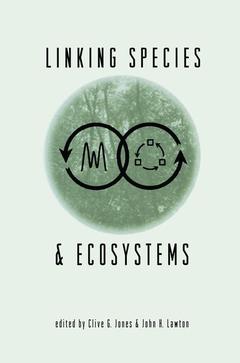Description
Linking Species & Ecosystems, Softcover reprint of the original 1st ed. 1995
Authors: Jones Clive G., Lawton John H.
Language: English
Subjects for Linking Species & Ecosystems:
Approximative price 158.24 €
In Print (Delivery period: 15 days).
Add to cart
Publication date: 10-2012
387 p. · 15.5x23.5 cm · Paperback
387 p. · 15.5x23.5 cm · Paperback
Description
/li>Contents
/li>
I was asked to introduce this volume by examining "why a knowledge of ecosys tem functioning can contribute to understanding species activities, dynamics, and assemblages." I have found it surprisingly difficult to address this topic. On the one hand, the answer is very simple and general: because all species live in ecosystems, they are part of and dependent on ecosystem processes. It is impossible to understand the abundance and distribution of populations and the species diversity and composition of communities without a knowledge of their abiotic and biotic environments and of the fluxes of energy and mat ter through the ecosystems of which they are a part. But everyone knows this. It is what ecology is all about (e.g., Likens, 1992). It is why the discipline has retained its integrity and thrived, despite a sometimes distressing degree of bickering and chauvinism among its various subdisciplines: physiological, be havioral, population, community, and ecosystem ecology.
Issues: Why link species and ecosystems?: a perspective from ecosystem ecology-- Nancy B. Grimm; Organisms and species as complex adaptive systems: linking the biology of populations with the physics of ecosystems-- James H. Brown; Scope: Bioturbators as ecosystem engineers: control of the sediment fabric, inter-individual interactions, and material fluxes-- Jeffrey Levinton; Biogeochemical processes and marine benthic community structure: which follows which?-- Anne E. Giblin, Kenneth H. Foreman and Gary T. Banta; Marine snow: what it is and how it affects ecosystem functioning-- M. W. Silver, S. L. Coale, D. K. Steinberg and C. H. Pilskahn; Floods, food chains, and ecosystem processes in rivers-- Mary E. Power; Population variability in experimental ecosystems-- Michael L. Pace; Stephen R. Carpenter, and Patricia A. Soranno; How important are consumer species to ecosystem functioning?-- Nancy Huntly; Linking tree population dynamics and forest ecosystem processes-- Charles D. Canham and Stephen W. Pacala; Soil organisms as engineers: microsite modulation of macroscale processes-- J. M. Anderson; Soil fauna: linking different levels of the ecological hierarchy-- Robert W. Parmelee; Beaver as engineers: influences on biotic and abiotic characteristics of drainage basins-- Michael M. Pollock, Robert J. Naiman, Heather E. Erickson, Carol A. Johnston, John Pastor and Gilles Pinay; Atmospheric oxygen and the biosphere-- Heinrich D. Holland; Approaches: Linking species and ecosystems: organisms as ecosystem engineers-- John H. Lawton and Clive G. Jones; Top-level carnivores and ecosystem effects: questions and approaches-- James A. Estes; Food webs in soil: an interface between population and ecosystem ecology-- Jan Bengtsson, David Wei Zheng, Goran I. Agren and Tryggve Persson; Unifying ecological subdisciplines with ecosystem food webs-- Neo D. Martinez; Coupling the dynamics of species and materials-- William S. C.Gurney, Alex H. Ross and Niall Broekhuizen; Exploring aggregation in space and time-- Monica G. Turner and Robert V. O'Neill; Aggregation of species properties for biogeochemical modeling: empirical results-- David S. Schimel, V. B. Brown, K. A. Hibbard, C. P. Lund and S. Archer; Functional redundancy and process aggregation: linking ecosystems to species-- Edward B. Rastetter and Gaius R. Shaver; Species compensation and complementarity in ecosystem function-- Thomas M. Frost, Stephen R. Carpenter, Anthony R. Ives and Timothy K. Kratz; Elemental stoichiometry of species in ecosystems-- Robert W. Sterner; Species, nitrogen and grassland dynamics: the constraints of stuff-- David A. Wedin; Relationships between the energetics of species and large scale species richness-- Donald L. DeAngelis; Linking species and ecosystems: where's Darwin?-- Robert D. Holt; Ecological flow chains and ecological systems: concepts for linking species and ecosystem perspectives-- Moshe Shachak and Clive G. Jones; Context: The relevance of ecology: the societal context and disciplinary implications of linkages across levels of ecological organization-- Jane Lubchenco; Linking species and ecosystems through training of students-- Lawrence B. Slobodkin; Linking species and communities to ecosystem management: a perspective from the experimental lakes experience-- D. W. Schindler; Why link species conservation, environmental protection, and resource management?-- Jerry F. Franklin; References; Index.
© 2024 LAVOISIER S.A.S.




